The Joy of Starter Kits, Part Two
Dungeons and Dragons Basic Set Second Edition,
edited by Tom Moldvay (TSR, 1981). Cover by Erol Otis.
I often wonder how new players discover role playing these days.
I mean, I know how it happens in theory. You’re introduced to the concept through video games, or friends, or a gaming club, or maybe Stranger Things. The whole thing sounds pretty cool. Eventually you take the plunge and shell out for a set of hardcover rule books and dice, and become a genuine RPG gamer. Sure, it’s a commitment. But it’s no more expensive than other pastimes of the idle rich, like polo or yacht racing.
It’s that initial expense that gets me. The D&D Players Handbook, the most fundamental RPG book on the market, retails for $49.95 — and it’s only one of three you really need. And that doesn’t even include dice. God knows how pricey those are these days.
It used to be easier. You used to be able to try D&D the same way your tried Monopoly, with an impulse buy of a single reasonably-priced box. That’s how I got started in the fall of 1979, when I bought the D&D Basic Set after seeing a few magazine ads in Analog and picking up a copy at the local gaming store. The sheer financial (not to mention emotional) commitment required of modern RPGs is a serious barrier to entry, and many game publishers have gradually come to that realization.
In Part One of this article I looked at some of the games that have embraced the old idea of the Starter Kit, an inexpensive box set that includes everything new players need to learn the fundamentals of role playing and have a few adventures. This new generation includes Pathfinder, Starfinder, Battletech, Numenera, Shadowrun, and others. In Part Two we look at Call of Cthulhu, Traveller, Star Trek Adventures, Warhammer, Star Wars, and the new breed of Dungeons and Dragons beginner boxes.
[Click the images for starter-kit versions.]
Chaosium’s Call of Cthulhu is one of the greatest role playing games of all time, and when I saw that they had released a Starter Set a year ago, I knew the concept of the Beginner Box had really returned.
I was especially pleased to see their take on the idea was being held up as an example for the rest of the industry. Here’s an excerpt from Antonios S’s review at RPG.Net.
This is a magnificent, perfect entry-level product. And no, this isn’t misplaced nostalgia about boxed sets of yore. This is exactly how a new entrant should get access into a game as rich and elaborate.
The first thing to notice is the price. Frankly, it is peanuts for what the boxed set contains. I have never, ever seen rules, one solo adventure, and three distinct adventures which can however be linked into a mini campaign in any other entry-level boxed set out there… The only product I remember having a similar approach years ago was the Dungeons & Dragons Basic Set from 1991, which incidentally also cost as much money nominally back in the day (!). Compared to this Starter Set however, its solo scenario was underdeveloped, amateurish even, while it contained only one adventure and not three. No matter how I see it, this Starter Set destroys all previous and current competition….
The solo adventure [One Against the Flames] is for me a hallmark of design, incorporating character creation inside the adventure instead of making it something extraneous, a chore to get rid of. This is a beautiful roleplaying lesson, if at a subconscious level: take a look at your surroundings, and then decide what is the best to play at that occasion. The pacing is great, progress is practically cinematographic… The rules in both the solo adventure as well as the simplified multiplayer adventures are extremely easy to grasp. I like how no rules will be taken out when one eventually transitions from this simplified ruleset to the full set of the Seventh Edition. Adding rules is simple. Changing rules is confusing. Chaosium opted for the first approach; it is the clever thing to do.
I enjoyed all three adventures, and this is no small thing. They are clearly written with the big-eyed, brand new Keeper in mind. Paper Chase is almost a fairy tale, since there is practically [no] antagonist. Its purpose is to show the players that there is a brave new unknown world, and that the axis of good/evil might be irrelevant… This is a story that reinstills the love of the game in its most innocent, most pure form.
Here’s a peek at the complete contents.
The boxed set contains:
– Book 1: Introduction and Alone Against The Flames — a solo introductory adventure, teaching you the basics of Call of Cthulhu as you play through a mystery.
– Book 2: Call of Cthulhu Starter Rules—the essential rules, everything needed for starting play.
– Book 3: Adventures—three starter adventures for your players to explore.
– Ready to Play Investigators—five ready to play game characters.
– Blank Investigator Sheets—ready for creating your own investigators.
– Roleplaying Dice – a set of six polyhedral dice for use in the game.
– Player Handouts – a set of ready to use props.Adventures!
This box comes packed with four classic adventures for over twenty hours of game play.
– Alone Against The Flames
– Paper Chase
– Edge of Darkness
– Dead Man Stomp
The Call of Cthulhu Starter Set was released by Chaosium on December 17, 2018. It retails for $24.99 and is still available. See an unboxing video and lots more details here.
I was surprised and pleased to find that Mongoose Publishing has released a Starter Set for the Traveller science fiction role playing game. It’s more ambitious (and more expensive) than most of the beginner boxes on this list, but still a good value.
Here’s the description:
With a wealth of high quality components, full color rule-books and a brand new campaign setting, the Traveller Starter Set is all you need to dive straight into the galaxy of the Far Future. Fully compatible with the latest edition of the Traveller Core Rule-book, the Starter Set provides a smooth route into the Traveller system, complete with easy-to-run adventures that introduce the rules gradually while forming part of an epic story line that will see the Travellers gamble everything in defense of their home-world against a terrible enemy before setting out on a desperate mission across the stars. Spaceports, ancient civilizations, air/rafts, cold steel blades, laser carbines, far distant worlds, and exotic alien beasts this is the futuristic universe of Traveller, the original and classic science fiction role-playing game, and it has never been easier to get into. Come visit the future.
And here’s what you get for your money.
The Traveller Starter Set contains:
Book 1: Characters and Combat
Book 2: Worlds and Spacecraft
Book 3: The Fall of Tinath
Giant blank Sector Maps
6 Pre-generated Character Cards
Traveller Starter Box was published by Mongoose Publishing on November 13, 2017. It retails for £50.00 (roughly $68 in the US), or £30.00 for the PDF version. Get more details at the Mongoose website.
I’m not familiar with the Star Trek Adventure Game from the prolific Modiphius Entertainment (publisher of the Coriolis science fiction RPG, Conan – Adventures in an Age Undreamed Of, and the new Alien: The Roleplaying Game), so their new Starter Set is a great test case for me.
Does it do a good job of introducing new players to the game? Let’s find out. The price is great (£20.00, about $27), and I ordered a copy with my Christmas money last week.
Here’s the back cover text:
Star Trek Adventures takes you to the final frontier of the Galaxy, with everything you need to begin playing the tabletop roleplaying game in one introductory boxed set.
The starter set contains:
Starter Rules booklet: Giving you an overview of the 2d20 system.
A Three-Mission Campaign Booklet: That guides you through the game mechanics as you play.
6 Pre-Generated Character Sheets: Including 5 Starfleet officers and 1 Galaxy-class vessel.
Dice: 2 twenty-sided dice (d20s) an 4 custom six-sided dice (d6s).
Tokens: Tokens for Momentum, Threat and characters.
Poster Maps: For locations in the campaign.
The Starter Set did its job on me, turning me into an instant fan. It’s one of my current gaming obsessions (along with the dark and moody Coriolis, which I hope to cover in a future post.) The Star Trek Adventure Game is very well supported, with a wide range of adventure supplements that would make great on my gaming shelf.
Some recent releases for Star Trek Adventures
After examining the Starter Set, I was intrigued enough to splurge on one of these titles, and ordered Strange New Worlds last week. (Mostly because of the awesome cover. The review at The Fandomentals, which says it “Introduces Some Old-School Weirdness To Star Trek Adventures,” didn’t hurt either.)
The Star Trek Adventures Starter Set was published by Modiphius in 2018. It retails for £20.00 (about $27 in the US); order copies and get more details here.
Our previous coverage of games from Modiphius Entertainment includes:
Raiders and Rogues in a Cursed World: Forbidden Lands by John O’Neill
Rethinking the OSR through Modiphius’s Conan – Adventures in an Age Undreamed Of by Gabe Dybing
Corporate Dystopia, Androids, Cults, Science, and even Archaeology: Alien: The Roleplaying Game by E.E. Knight
Next one: another classic of old-school gaming.
The Warhammer Fantasy Role Play Starter Set was the last one I found while doing my research, and I think it’s because it wasn’t well advertised on this side of the Atlantic. Here’s the publisher’s description.
Enter the grim world of perilous adventure! The present set includes an exciting adventure that teaches the rules as you play, along with over 100 pages of scenarios, locations,history, and introductory rules.
The WFRP Starter Set contains everything needed to bring the grim and perilous world of Warhammer Fantasy Roleplay to life. Whether roleplaying for the first time or preparing for your next epic campaign, this box is for you.
With over a hundred pages of adventures, rules, and setting, as well as maps, handouts, custom dice from Q Workshop, Advantage tokens, rules references, ready-made Characters, a simple GM Screen, and more, this boxed set is the perfect starting point for anyone interested in WFRP.
The Adventure Book invites players of all experience levels into the rich, roleplaying playground of Ubersreik. For beginners, the starter adventure, Making the Rounds, introduces the harsh realities of life in the troubled fortress-town and takes you step-by-step through the rules. For more experienced hands, there are 10 scenarios aimed to expand your WFRP games, offering new locations, new characters, and new horrors to uncover. Coming in at 48 pages, The Adventure Book is the ideal launching point for any new campaign, and can keep your WFRP group busy for several months.
The 64-page A Guide to Ubersreik highlights the bloody history and recent invasion of Ubersreik, examines more than 70 locations in the troubled town, details the surrounding fiefdoms, and introduces a wide array of antagonist cults at large in the area. In addition, each entry comes with two adventure hooks, meaning every location, character, and political pitfall the book presents has examples of how to use them on your games of WFRP.
The Warhammer Fantasy Roleplay Starter Set contains everything you need to start an epic campaign.
And here’s the complete contents:
– Read This First! Introduction sheet;
– 6 Ready-made Characters
– The Adventure Book
– A Guide to Ubersreik
– 3 Rules Reference Sheets
– 3 Handout Sheets
– 49 Advantage tokens
– 4 highly detailed maps
– 2 custom dice from Q Workshop
– A simple Gamemaster Screen.’
Antonios S has another detailed review of this one at RPG.Net as well, saying in part:
The rules in the set are minimal and take no more than a handful of pages. A few reads of The Adventure will prepare even the greenest of GM’s for their first Warhammer adventure… The plot is rather straightforward, yet it contains all the elements that make Warhammer what it is: unexpected situations and whimsical twists, weirdness, and quaint names and humour of a borderline adolescent nature. I suppose you are doomed to become a thief when your father is called Fartomeous….
Talking of quaint names and fluff unlikely to be seen in other fantasy games, A Guide to Ubersreik is the sort of place I expected it to be: rough, rude, yet alluring. With places like ‘Upper Teufel’ (literally: Upper Devil) and with writing and immediately usable details that could put dedicated region books to shame, this book alone will tempt even Warhammer veterans towards purchasing the Starter Set….
I enjoyed practically all the components inside the box. Presenting the few rules that are needed in loose leafs so that the characters can access them is mighty practical. What I really enjoyed however is how the product transformed a non-space (the interior of the box’s lids) into a simple GM screen… Something tells me that this approach is bound to become an industry standard.
The Warhammer Fantasy Roleplay Starter Set was published by Cubicle 7 Entertainment in 2019. It retails for £22.99 (about $29 in the US) and is still available. Order copies online here.
Now we come to Fantasy Flight and their family of Star Wars games, each of which has a separate Beginner Box.
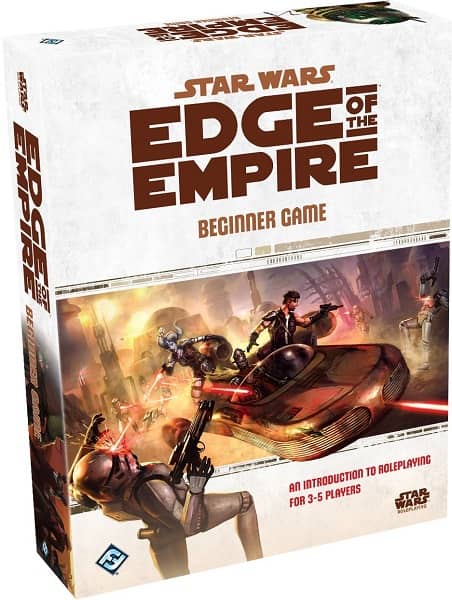 |
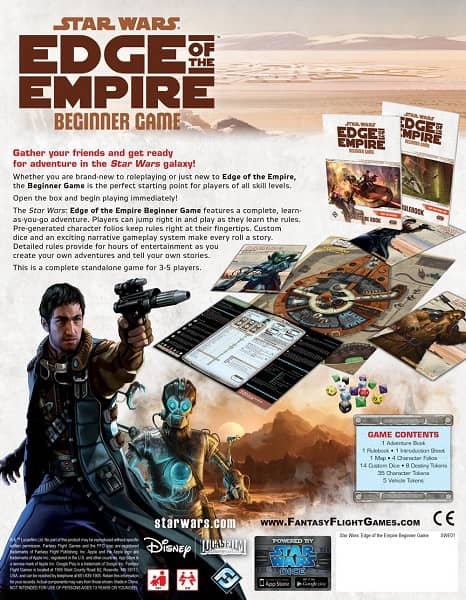 |
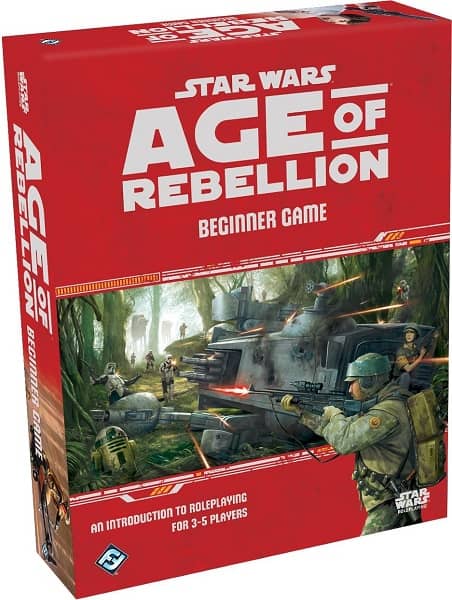 |
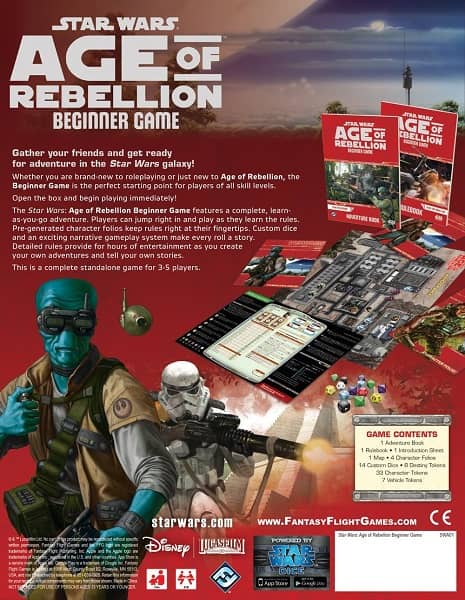 |
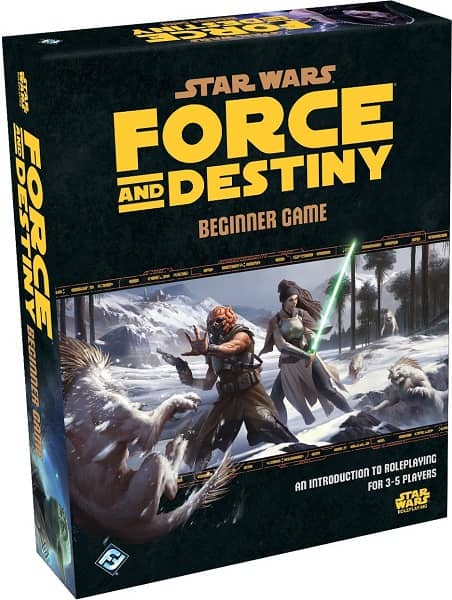 |
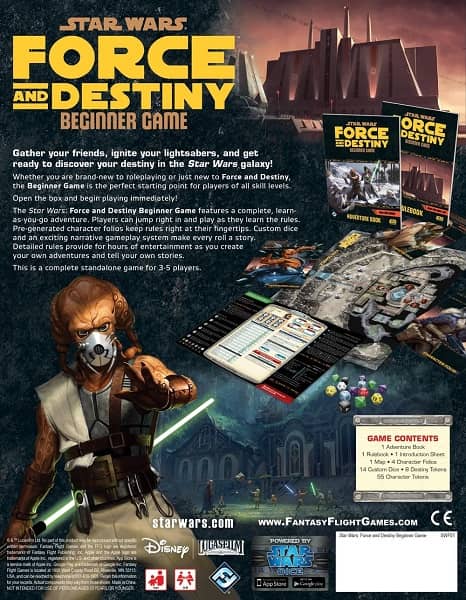 |
To be honest, I wasn’t clear on the differences between each of these games until I started researching for this article. But I was a huge fan of Fantasy Flight’s (now defunct) Warhammer 40K RPG system of five independent RPGs: Dark Heresy, Rogue Trader, Deathwatch, Black Crusade, and Only War, and how the separate systems allowed you to play very different roles in the same setting — Inquisitors, ultra-rich independent traders, loyalist Space Marines, agents of Chaos, and Imperial Guardsmen, respectively.
I assume these three games follow the same basic idea, allowing you to play different character types in the Star Wars Universe. If I have the details right, these are:
Star Wars: Edge of the Empire — focused on story-rich locations where morality is gray and nothing is certain. Hired Gun, Bounty Hunter, Explorer, Colonist, Technician, and Smuggler
Star Wars: Age of Rebellion — members of the Rebel Alliance. Soldiers, Spies, X-Wing pilots, etc.
Star Wars: Force and Destiny — Jedi Knights
All three boxes retail for $29.99. The first two are widely available, but Force and Destiny is currently sold out in most online shops I checked, and prices are already starting to creep up. I assume it will eventually get reprinted, but if you’re curious you may want to keep an eye on it.
The Star Wars: The Force Awakens Beginner Game
There’s also a Star Wars: The Force Awakens Beginner Game. Honestly I have no idea what that one’s about.
If you’re going to step into the wide world of Star Wars role playing with these Beginner Boxes, you should be aware that each of them has a core rulebook (which retails for $59.95) and assorted support materials. Fantasy Flight also has a deep bench of Star Wars board games, including the popular Star Wars: Armada and Star Wars: Rebellion., which retail for $99.95.
This could get expensive fast, is what I’m saying. Don’t blame me if you end up impoverished in a Star Wars rehab clinic.
See the entire universe of Fantasy Flight Star Wars games here.
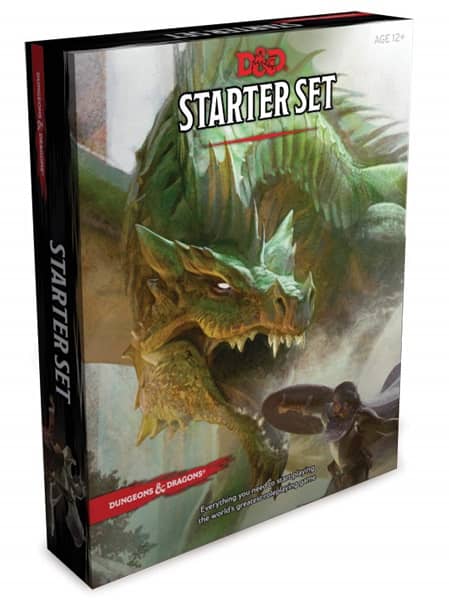 |
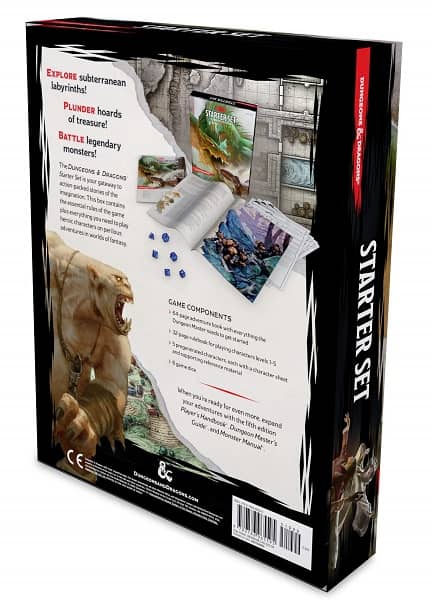 |
And now we’re back where it all started, with Dungeons and Dragons.
TSR introduced the concept of the RPG starter set 43 years ago with the J. Eric Holmes Dungeons and Dragons Basic Set in 1977. It was a huge success, going through numerous revisions (including the 1981 edition with the iconic Erol Otis cover, reproduced at the top of this article). It introduced hundreds of thousands of players to the game over the years, including me. 1994 was the final edition, and by the late 90s there were no more D&D Basic Sets.
Wizards of the Coast reintroduced them with the Fifth Edition D&D Starter Set in 2014, followed by the D&D Essentials Kit in 2019.
How are they different? Again, I had no idea until I started digging into the details for this article.
The Dungeons & Dragons Starter Set contains everything you’d expect to see:
D&D Starter Set Rulebook (32 pages)
Lost Mines of Phandelver adventure/campaign book (64 pages)
Six polyhedral dice (blue with white numbers)
Five pre-generated characters printed on the new D&D 5e character sheets
– Human Fighter (Greatsword, high Dex)
– Human Fighter (GreatAxe, high Str & Cha)
– Dwarf Cleric
– Halfling Rogue
– Elf Wizard
– One blank character sheet
The Starter Kit retails for a bare bones $19.99, which makes it the least expensive boxed set on this list — and by far the most economical introduction to modern role playing on the market.
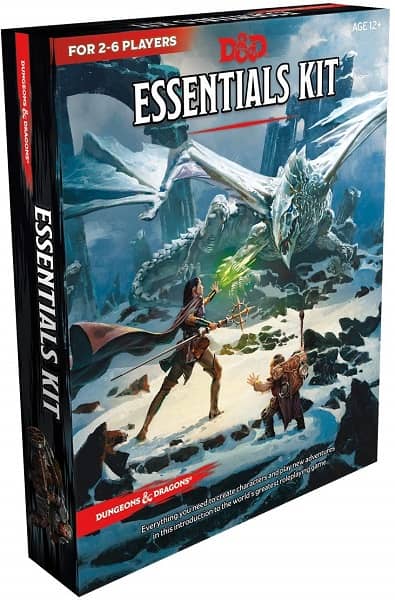 |
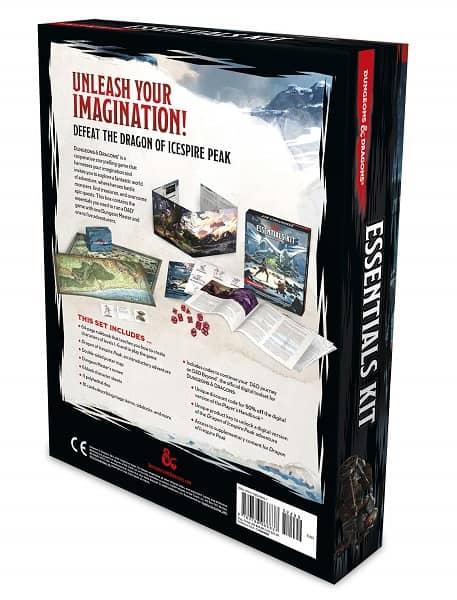 |
The Dungeons & Dragons Essentials Kit is where things get a little more interesting. It’s five bucks more expensive than the Starter Set, and advertised as “Everything you need to create characters and play new adventures.” But do you need it?
David M. Ewalt seems to think so. In his impressively compact 50-word review at Forbes he wrote:
The Dungeons & Dragons Essentials Kit is the perfect introduction to the legendary role-playing game. It includes simplified rules, an adventure, maps… everything you need to start as player or dungeon master. People often ask me how to get started playing D&D, and now I can tell them: This is the best introduction to D&D ever.
The Essentials Kit isn’t a supplemental product for those who already have the Starter Kit; it appears to be an up-to-date replacement. It contains:
Rulebook
Dragon of Icespire Peak introductory adventure
6 blank character sheets
11 dice
33″ × 8.5″ Dungeon Master’s screen
81 cards for magic items, sidekicks and more,
21″ x 15″ double-sided poster map for use with the adventure,
code for 50% the digital version of the Player’s Handbook, access to supplementary content, including additional adventure materials to continue the story into higher levels of play.
If you’re only going to buy one boxed set to introduce you to Dungeons & Dragons — perhaps, indeed, one boxed set to introduce you to role playing in general — the Essentials Kit might be the best choice.
The Dungeons & Dragons Starter Set was published by Wizards of the Coast on July 15, 2014. It retails for $19.99 and is still available.
The Dungeons & Dragons Essentials Kit was published by Wizards of the Coast on September 3, 2019. It retails for $24.99 and is widely available.
That wraps up our coverage of the best new RPG Starter Kits on the market today. Did I miss any, or are there new ones in the pipeline for early 2020? Probably. If you know of any worth mentioning, let us know in the comments.
See all our recent Role Playing Game coverage here.
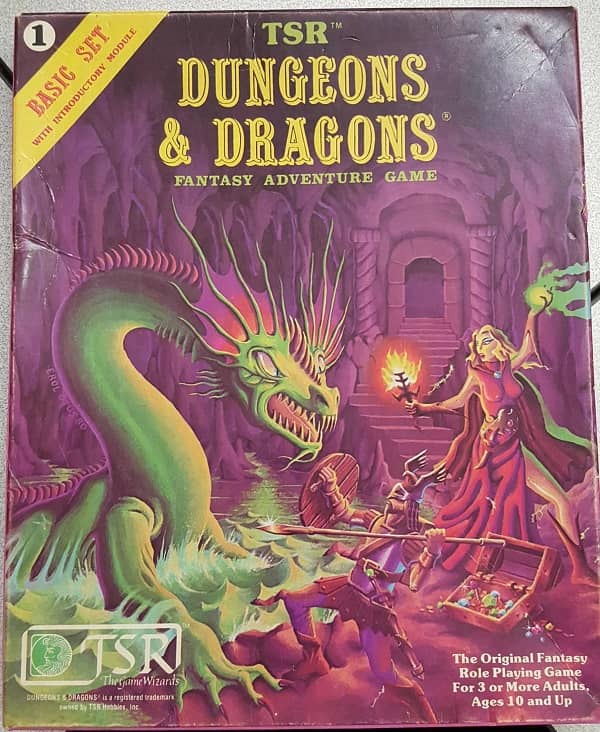
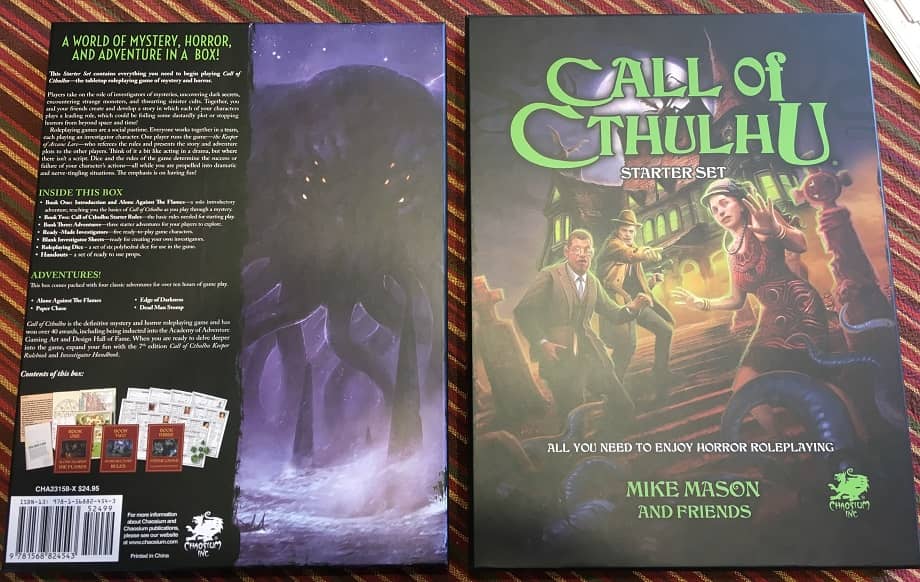
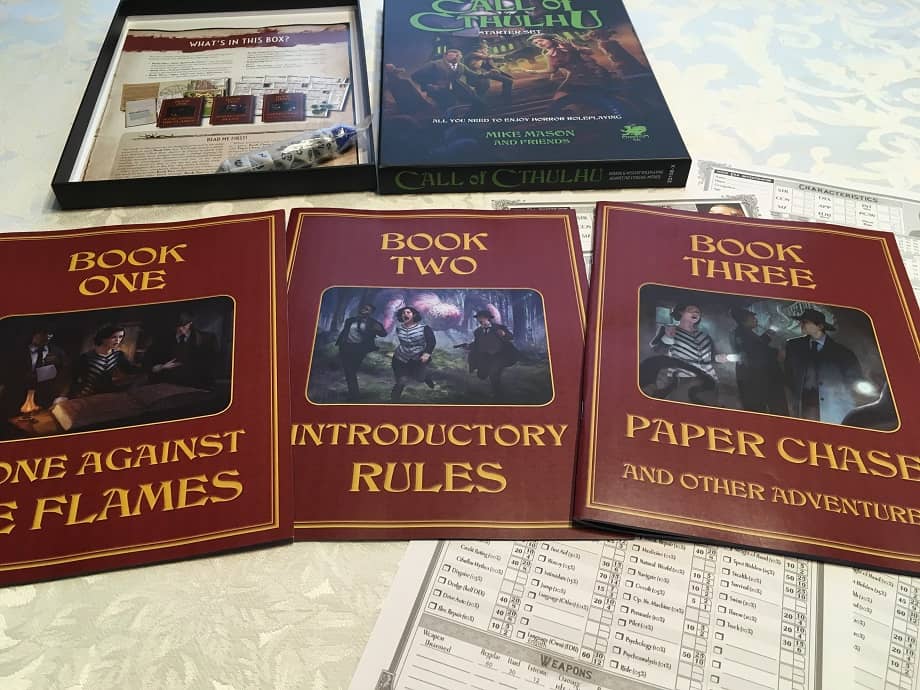
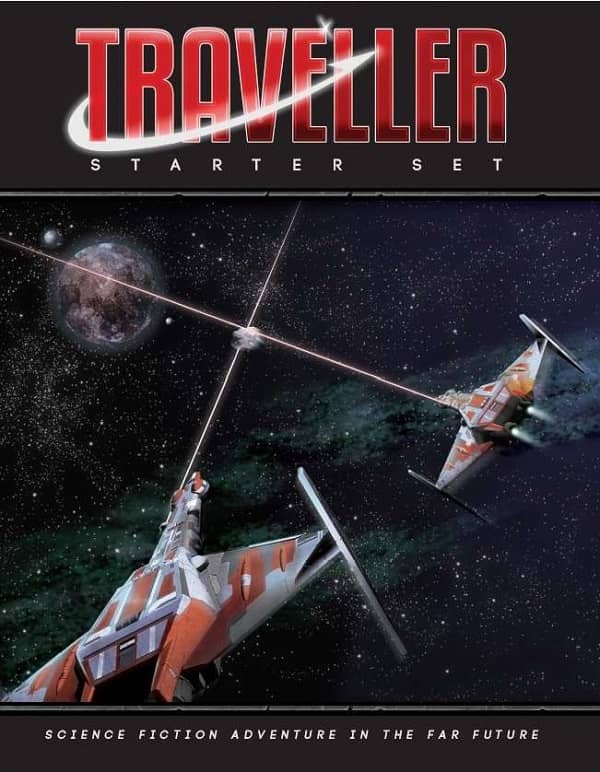
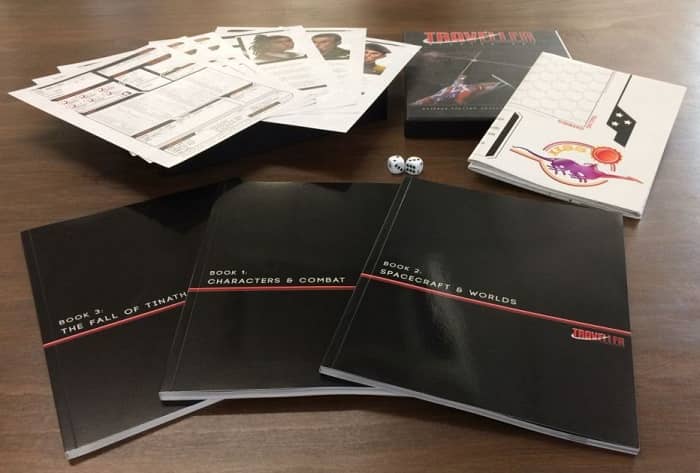
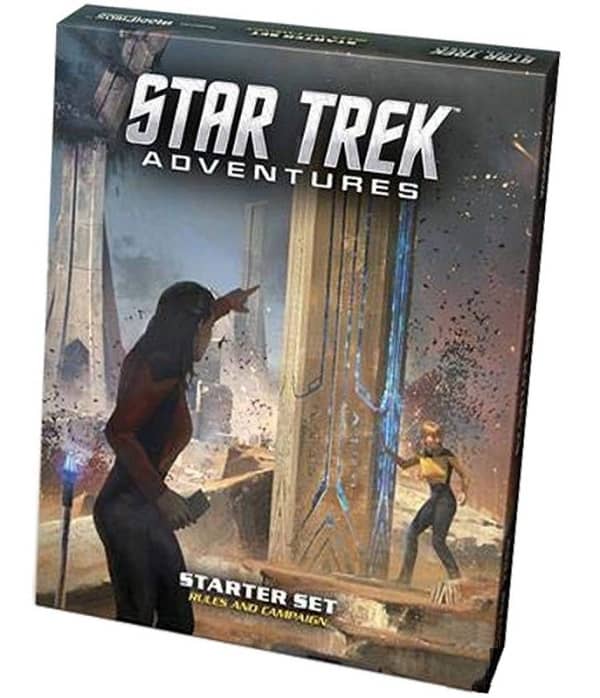
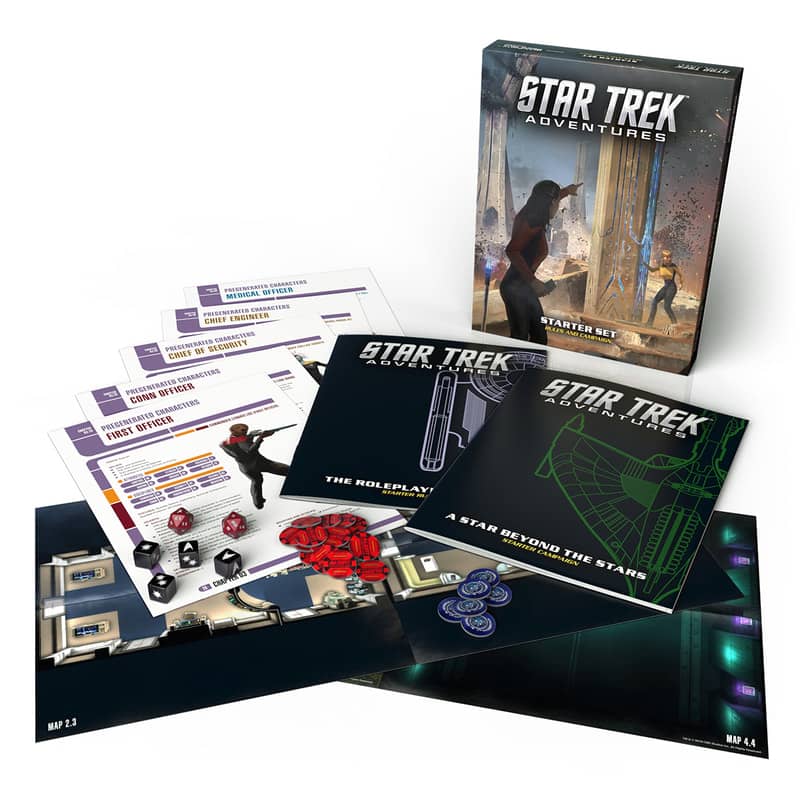
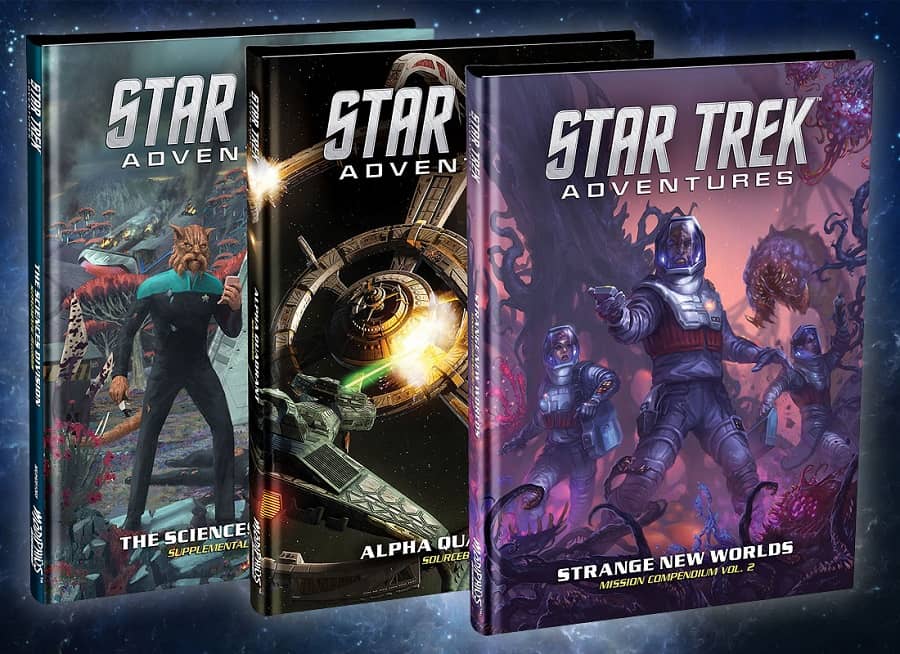
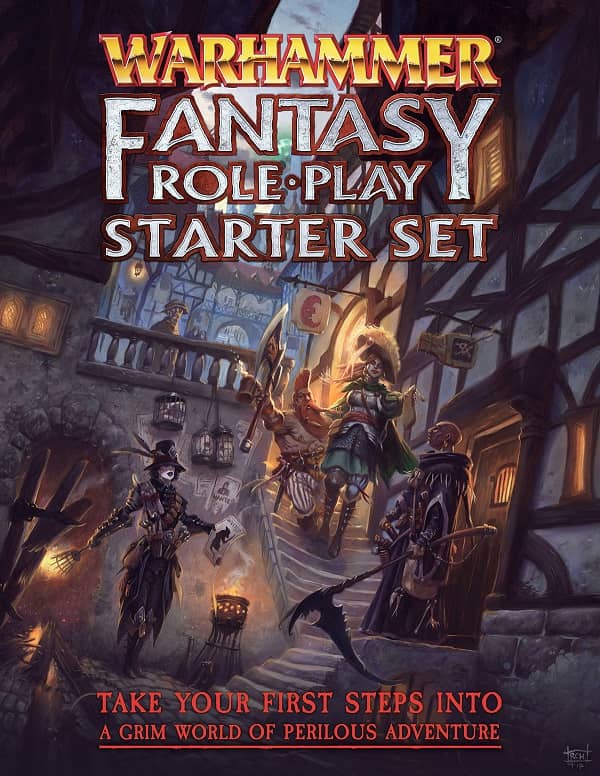
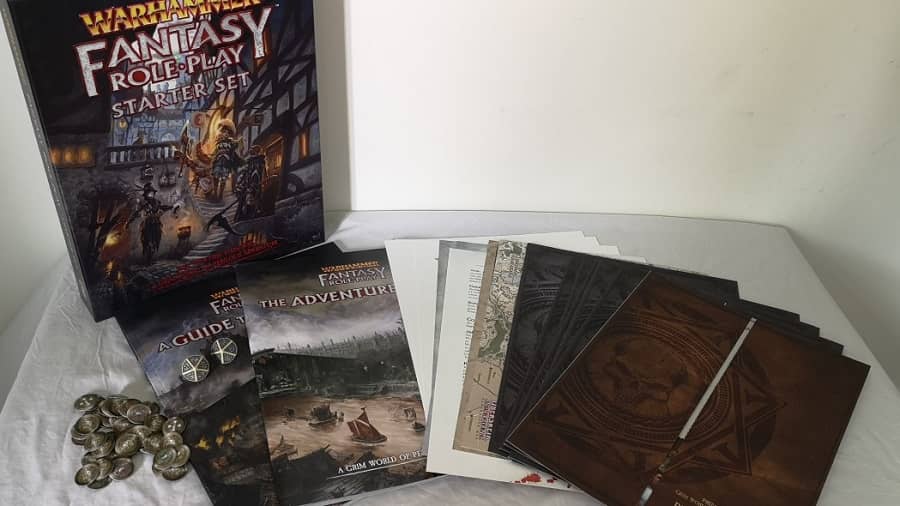
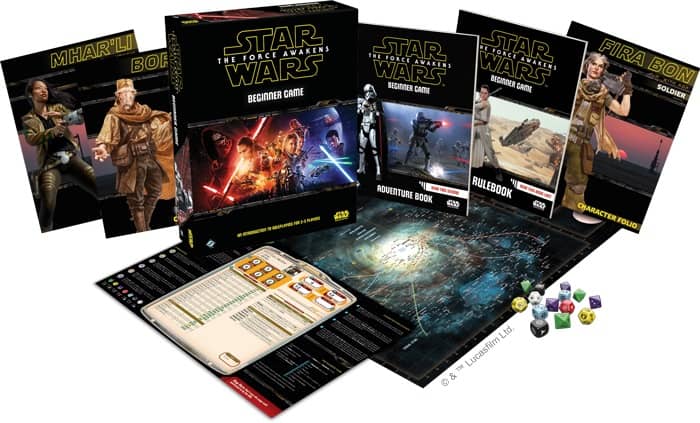
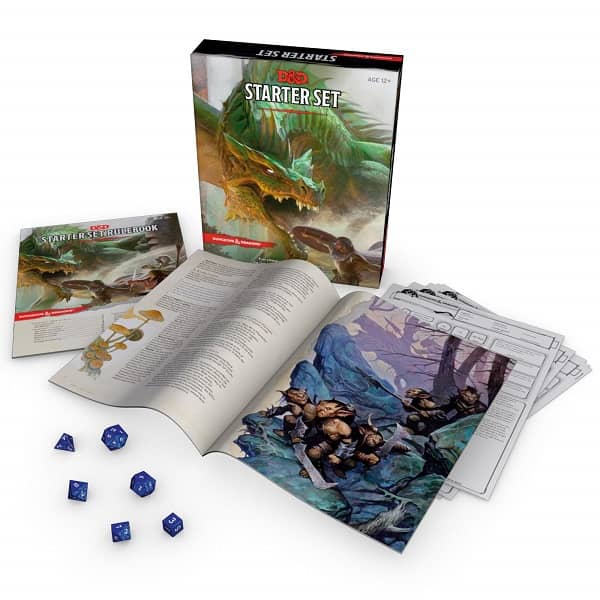
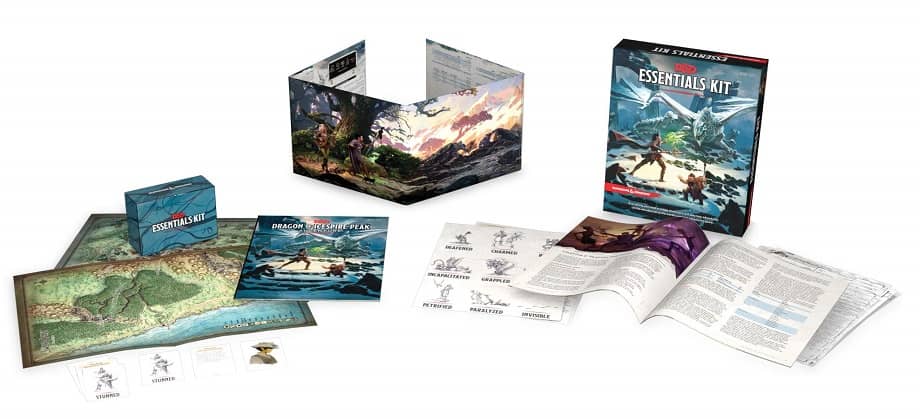
There was a starter set in 2004 from WOTC called the Dungeons & Dragons basic game. In addition to the usual ingredients it also had pre-painted miniatures. I think it was the first set I used to introduce my kids to rpg’s.
I have the D&D Essentials Kit, and it really is very good. It has rules for building and advancing five character classes (fighter, rogue, cleric, wizard, and bard) and four races (human, elf, dwarf, and halfling), and although it doesn’t provide all the options for them, it doesn’t pre-build them for you either. Best of all, the adventure–which takes you from 1st all the way to 7th–scales so that you can play it with just two people, the DM and a PC. It was a good way to introduce my wife to D&D.
i also put my full endorsement behind the D&D Essentials Kit. Love what they did for low level group play and using that to get someone into D&D that is very shy. playing with one other person they are comfortable with, i find opens them up to want to play with others to see how different classes, and character ideas come into play.
you know what else the starter set’s are good for? if you like the property, and just want to check out the game and some lore with it, they usually provide you with enough info to then decide to buy in full. that isnt always the same with other demo like products.
> There was a starter set in 2004 from WOTC called the Dungeons & Dragons basic game. In addition to the usual ingredients it also had pre-painted miniatures.
rtorno,
I totally missed that one. Thanks for the tip! There are a handful of sellers on Amazon who still have it in stock.
This one seems a little light on adventures, and heavy on miniatures. Looks like it’s based on the D&D 3.5 ruleset. What did you think of it?
John ONeill- That’s a fair assessment. The 16 miniatures weren’t a bad start and the dungeon tiles were first rate. The quick start rules were bare minimum but the advanced rule book did a pretty good job of giving you a very simplified PH, DMG, and MM in about 60 pages and encouraged more of a home-brew dungeon creation for DM’s over giving a finished adventure. It also had perforated cards for monster and character reference which wasn’t a bad way to go. It was a good introduction for new players but held the DM’s hand a bit less than most boxed sets.
I really enjoyed both articles. They made me nostalgic for all the classic boxes I have on hand and you make a good point on how much these sets do to pull new players in.
Another D&D starter set, just for the sake of completeness:
https://rpggeek.com/rpgitem/56515/first-quest
First Quest, a box for AD&D 2e — of particular interest because it included an audio CD (soundtrack with occasional sound effects overlaid, I believe), and because it started in Mystara (the Known World setting for the BECMI D&D system) and ended up as a Spelljammer adventure.
> I have the D&D Essentials Kit, and it really is very good… It was a good way to introduce my wife to D&D.
Donald,
You’re a good husband to introduce Kristin to D&D (and what took you so long??) 🙂 Say hi to her for us. When are you two going to come hang out with us at conventions again?
Also, how is the online Mysterion magazine doing? I noticed you’re open to submissions until the end of the month.
> you know what else the starter set’s are good for? if you like the property, and just want to check out
> the game and some lore with it, they usually provide you with enough info to then decide to buy
Dante,
That’s a great point. You don’t have to play the Essentials Kit to get great value out of it. One read-thru can give you a solid taste of the property and the gaming system, and help you decide if you want to make a bigger investment. Someone shopping around for a new game can sample a lot of systems relatively inexpensively this way.
> I really enjoyed both articles. They made me nostalgic for all the classic boxes I have on
> hand and you make a good point on how much these sets do to pull new players in.
rtorno,
Glad you enjoyed the articles! Any of the new boxed sets appeal to you more than the others? I admit I’m drawn to the Star Trek and Star Wars sets… but maybe that’s because I just saw The Rise of Skywalker!
> First Quest, a box for AD&D 2e — of particular interest because it included an audio CD
> (soundtrack with occasional sound effects overlaid, I believe), and because it started in Mystara
> (the Known World setting for the BECMI D&D system) and ended up as a Spelljammer adventure.
Joe,
Good memory! I forgot all about that one.
By the late 90s TSR was trying all kinds of creative things with their box sets, including audio CDs, interactive VHS tapes, and the like. They were trying things like the Birthright in which you role-played whole families and kingdoms (and passed along divine attributes), not just players.
Sadly, all of it failed. None of the products sold nearly as well as the early Forgotten Realms and Greyhawk boxes. By 1997 they were facing bankruptcy and were acquired by Wizards of the Coast.
I assume it was that thinking — if not even TSR can make money selling box sets anymore, how can the rest of us? — that resulted in the entire industry moving away from them.
John ONeill- Of the ones I don’t already own the Call of Cthulhu box interests me the most. I have 7th edition but I’ve been playing a great deal of Cthulhu: Death May Die (an absolutely great board game with some first class miniatures). The group I’ve been playing it with have never played any TTRPG’s and this starter set looks like a good way to break them in and lead into some of the massive campaigns that COC has to offer.
rtorno,
I’m glad you mentioned Death May Die. I was looking at it online just a few days ago. It looks like a lot of fun. Is is playable with just 2-3 people?
I’ve been running a weekly 5e game since last February using the modules from Lost Mine of Phandelver and more recently the Essentials box. We’re still going strong.
Both boxes have their positives and negatives. I think there is enough variety in both that you can justify owning each.
The Starter Kit is better for completely new players and its module has a nice narrative arc and teaches a new group how to integrate NPCs into player back stories.
The Essentials kit has more stuff, a physical map of the starting town and surrounding area as well as physical cards to hand out for status effects, magical items, and quest cards.
But the Essentials module is more of a sandbox game. While thee encounters are more varied than whats in the Starter Set, they don’t form any kind of a narrative arc.
So if you’re running with an old school group that wants to try out 5e and likes a more open game then go with the Essentials box.
And if you’re running first timers and want a game with a stronger narrative arc then go with the Starter Set.
I have quite a few 3.5 low level modules and I think these 5e books are better than most of those.
Thanks for the tip about the Star Trek starter set. I’ve got one player who is a huge fan and he’s never run an RPG before. Star Trek would be a great fit for him to run.
John ONeill- It is indeed a lot of fun. It can be played with up to five people and also allows solo play, but 2-3 works out very well. More players tends to decrease the difficulty level but still doesn’t ensure an easy win. Unlike most Lovecraft games you are intended to attack and potentially defeat elder gods so it wouldn’t fit everyone’s conception of HPL themes but everyone I’ve played with so far has had a great time and the co-op strategy aspect of the game makes for an easier transition to TTRPGs over traditional competitive boardgames.
Just a minor point — the Holmes and Moldvay boxed sets were actually not that cheap back in the day.
Original D&D boxed set sold for $10 in 1974, which is $51 in today’s dollars (!). Minimum wage then was $2 per hour, so that was 5 hours of labor. Today that would be equivalent to 7 hours of labor at $7.25 per hour.
Holmes Basic sold for $9.95 when first released in 1977, which is $42 in today’s dollars. Minimum wage was $2.30, so you could buy it with merely 4.33 hours of labor; today it would require 5.79 hours of work at minimum wage of $7.25 in 2020.
Moldvay Basic sold for $12 when first released in 1981, which is $34 in today’s dollars. That is 3.58 hours at 1981’s $3.35 minimum wage, or 4.7 hours of labor at $7.25 today.
Essentials is $24.95 MSRP ($15.75 on Amazon), so that is 3.44 hours of labor for buying it at your FLGS, or 2.17 hours of labor for buying it off Amazon with Amazon Prime.
The modern Essentials box is an AMAZING deal, as it is not only cheaper, it is also packed with far more than the early starters had.
And didn’t the original Empire of the Petal Throne boxed set retail for some kind of princely sum? $25 or even $50 in 1975?
Just to provide more context, I have a hardcover book from 1976 that would’ve retailed for $6.95, and paperbacks were somewhere in the range of a buck each.
> Both boxes have their positives and negatives. I think there is enough variety in both that you can justify owning each.
Glenn,
Thanks for the detailed comparison. From the sound it it, both boxes are well worth buying just for the lengthy adventures within. That’s what I wanted to hear.
The Star Trek game looks very well supported. I’ve spent too much money on it already….
> It is indeed a lot of fun. It can be played with up to five people and also allows solo play, but 2-3 works out very well.
rtorno,
Excellent! Thanks for letting me know. Now I just need to convince my wife and kids to play it with me.
> Just a minor point — the Holmes and Moldvay boxed sets were actually not that cheap back in the day.
James,
You know, that’s a very good point.
Still, my recollection of the Holmes set isn’t that it was pricey — it’s that it had everything you needed. Dice, rules, starter adventure. It was affordable by a teenager whose major income source was babysitting.
Anyway, your point is a good one — and it emphasizes what a bargain the D&D Starter Kit and Essentials Kit are today.
> The modern Essentials box is an AMAZING deal, as it is not only cheaper, it is also packed with far more than the early starters had.
You’re absolutely right. I hope that thing sells a ton of copies. I’d like to see it available for a long time.
> And didn’t the original Empire of the Petal Throne boxed set retail for some kind of princely sum? $25 or even $50 in 1975?
Joe,
That’s a good question. I’m pretty sure you’re right because, one, it’s PACKED with stuff, and two, I couldn’t afford it back in the day. I had to hunt down a copy on eBay and pay late-90s collectors price for it (which admittedly were MUCH less than you’d pay for it on eBay today, where complete TSR editions sell for $300 and up).
Vintage role playing material has gone up a lot in the last 20 years. And I thought online prices were crazy in 1999….
EPT sold for $27.50 when OD&D was merely $10 so that is the equivalent of $130 today!!! A princely sum indeed!
James,
Wow! Yeah, no wonder I couldn’t afford it back in the day. 🙂
Interesting article with loads of interesting and informative comments. I am glad the boxed starter set has not been consigned to the annals of history. Recall the relatively common site of a battered red D&D Basic Set (Elmore cover) in the late 80’s. The quintessential hand me down from older siblings or friends who had – hopefully – moved onto more advanced systems and settings.
Kudos to the companies who are in all likelihood doing more than a public service, than making any kind of profit with such endeavours. Indeed many may be happy to slimy break even. Makes one wonder what the conversion rate could be? Say one in five buyers of that amazing looking Cthulu starter comes back to buy the deluxe edition?
Love the idea of the starter that gets added to. In the past mistakes were often made where the starter was a broken down version of the rules and as such became frustrating, potentially harming that games reputation. Avalon Hill’s attempt at this with the RuneQuest Basic (blue) box being case in point.
My contribution to successful starter sets:
A bit lateral as not a RPG but using the same theme. Iron Crown Enterprises’ Silent Death Unleaded game. The original game, a fast paced space combat miniatures game, called Silent Death : Metal Express was a hit at the time but due to the lead miniatures that came with it was also somewhat pricy. The solution was an Unleaded Introductory Set. Pretty much the same game but without the minis and smoother flash.
A small followup. It was fortuitous I only read this and its predecessor at]yesterday. Today I happened to make an unplanned trip and in so doing had an opportunity to browse a games shop I had not previously visited. A number of the new generation starter sets discussed in these articles were on the shelf, some at quite reasonable prices, considering they are all imported.
One I have not seen mention of here, although to be honest maybe a comment i missed, was the new Legend of the Five Rings starter. The price was somewhat more than say the D&D or Numericon items, but it also looks like there is much on offer in the box. Does anyone have more they can add on this one?
> Makes one wonder what the conversion rate could be? Say one in five buyers
> of that amazing looking Cthulu starter comes back to buy the deluxe edition?
Tony,
That’s a great question! I assume the rate has to be slightly higher than that, but in truth I have no idea. Anyone know?
> Iron Crown Enterprises’ Silent Death Unleaded game. The original game,
> a fast paced space combat miniatures game, called Silent Death : Metal Express
> was a hit at the time but due to the lead miniatures that came with it was
> also somewhat pricy. The solution was an Unleaded Introductory Set. Pretty
> much the same game but without the minis and smoother flash.
Interesting choice! It didn’t occur to me because it’s not an RPG. But it’s still not a bad example. ICE replaced all the minis with cardboard counters and cut the price dramatically… but that boxed still still came crammed with stuff!
You can see close-ups of the set above here, here, here and here.
> I have not seen mention of.. the new Legend of the Five Rings starter. The price
> was somewhat more than say the D&D or Numericon items, but it also looks like
> there is much on offer in the box. Does anyone have more they can add on this one?
Tony,
We covered it in Part I of this series, at the bottom of the list (next to the Shadowrun box):
https://www.blackgate.com/2019/12/18/the-joy-of-starter-kits/